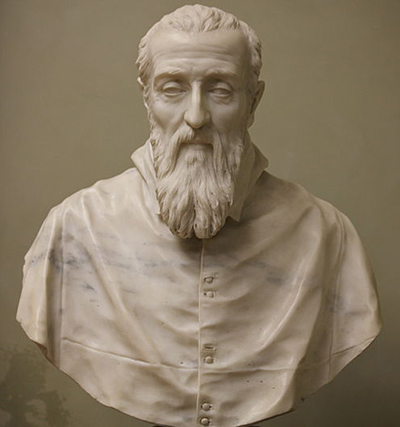Gian Lorenzo was greatly influenced by his thorough study in the Vatican of the Roman marbles and Greek antique.
He studied intimately and made an acquaintance with the Renaissance painting during the 16th century. Gian Lorenzo studied Michelangelo, and his work shows this in his 1617’s St. Sebastian. Gian Lorenzo also carved a bust of Cardinal Barberini, who became Pope Urban VIII and the greatest patron of Gian Lorenzo Bernini.
The bust of Cardinal Agostino portrays a new awareness of the significant relationship between the body and the head. Gian Lorenzo was able to display an inert ability to portray brief facial expressions. These facial expressions were shown with sharp realism. Realism is a philosophy that shows physical objects continuing to exist even when they are not perceived. This philosophy was learned by Gian Lorenzo in his Greek antique studies.
Gian Lorenzo’s marble works of the Bust of Cardinal Agostino shows a talent that is unparalleled when it came to carving tough material to achieve the desired delicate effects that are a preserve for bronze works. It shows that Gain Lorenzo was a master artist of high repute.
Looking at Gian Lorenzo’s enhanced awareness of Cardinal Giovanni’s, one can see a surface texture of hair and skin. Gian Lorenzo shows an innovative intellect of shading that differed from Michelangelo’s tradition and marked the beginning of a new period in Western or European sculpture.
The marble Bust of Cardinal Agostino shows dominance and originality of sculpture by Gian Lorenzo. In this bust of Cardinal Agostino’s, the background is blurred to bring the clear and visual expression of Cardinal Agostino’s face. It was a style that is portrayed in Gian Lorenzo’s works. It is his trademark that distinguishes his works from his predecessor like Michelangelo. Gian plays around with light and the dim light in the background, which shows that the Cardinal’s bust was drawn when he was about to sleep or not fully woken up. It is enhanced by the sleepy look in Cardinal Agostino’s eyes.
Unlike in other marble works by Gian Lorenzo like Pope Urban VIII’s portrait, the Bust of Cardinal Agostino is smooth. Gian did not leave it rough, and this brings out a relationship that was smooth between them by inference. It is work that was made to the greater finesse of polished glossy. Gian still experiments with light by showing some brightness on the forehead of the cardinal and looking at the left of his garment; one can see a manifestation of life.
Unlike what cardinal’s wear, Gian Lorenzo diverts with a free mind in art, and he does not portray a cardinal in choir dress and cardinal garments that include the blood-like red which symbolises a cardinal's readiness even to die defending his faith. The Bust of Cardinal Agostino excludes the mozzetta (cape) or the biretta (the stiff cap with ridges across the crown). It was Gian’s presentation of the theme of humanism – which means the man was in charge of his affairs.
Gian Lorenzo Bernini artistic works in sculpture left an impressive output of sketches and paintings. His works of sculpture provide us with emotion that we can relate to even today. His Baroque and Renaissance periods bequeathed us a path into works of sculpture like the Bust of Cardinal Agostino that we must study to the very end.




